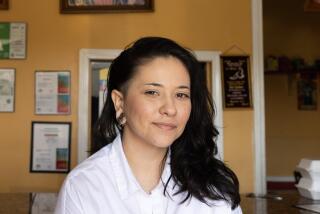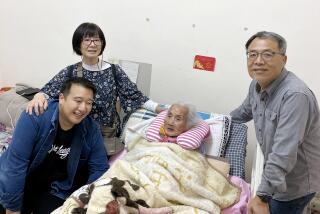Learning the Language of the Ancestors : * Culture: Lithuanians flock to St. Casimir’s Catholic Church in Los Feliz to study their heritage.
- Share via
It’s Saturday morning, and 3-year-old Laura Ellner normally would be at home in Anaheim Hills watching her favorite cartoons.
But on this morning, the wide-eyed girl is sitting in a circle at the West Coast’s only Lithuanian school, listening to stories of her heritage and writing her name in large colored letters in a language still foreign to her. It is the language of her ancestors.
So began the new school year recently at St. Casimir’s Lithuanian Catholic Church in Los Feliz for Laura and about 130 other students, young and old, who are seeking out their past during a period of historic change in Lithuania.
This is a ritual that Laura and her mother will continue each Saturday morning through June, making the young girl the second generation in her family to spend part of the weekend learning Lithuanian language and culture.
At times, Laura will no doubt want to be anywhere but in school on a Saturday. Her mother, Vida Slapelis Ellner, 34, knows the feeling.
The American-born mother spent her Saturdays the same way during her childhood in New York. “All our friends used to watch cartoons, and we’d have to come to Lithuanian class,” she said.
But as long as those mornings may have seemed, Ellner says now that keeping the language and culture of her ancestry alive is as important to her as it was to her Lithuanian-born parents--especially in the wake of independence for Lithuania and two of its Baltic neighbors.
“It’s not easy,” she says. “It takes a commitment.”
Ellner plans to drive Laura from Anaheim Hills to the school each Saturday by 9 a.m., staying there to talk with other Lithuanian-American parents until classes let out four hours later.
“It’s a joyous occasion,” school co-principal Maryte Newsom, a resident of West Los Angeles, told students and families in welcoming them to the school.
“This time it’s a different opening of the school because of the freedom in Lithuania,” she said. “The work has just begun, and don’t think on Saturday you can snuggle in your cozy beds to watch cartoons. Now we really have to learn Lithuanian well.”
Lithuania, along with the republics of Latvia and Estonia, was seized by the Soviet Union under dictator Josef Stalin in 1940. But now, after years of struggle, it has been able to regain its freedom amid the dramatic collapse of the Soviet Union’s system of Communist rule.
Southern California’s estimated 60,000 Lithuanian-Americans have cheered the developments, and some at St. Casimir’s school say they plan to return to Lithuania to visit or study. At the very least, they say, independence should mean easier communication with family and friends living in the Baltics.
And school co-principal Algimantas Zemaitaitis, 59, who left Lithuania at age 12, says the school will need to reassess its own goals and practices as the dream of independence has moved from “fairy tale” to reality.
“The language will be easier to teach because most of the students will be going back to visit,” he said. “A number of our restless young people have become quite patriotic.”
As classes began, parents, students and school officials displayed their excitement over the recent turn of events, with some wearing shirts decorated with ribbons in colors of the Lithuanian flag--gold, green and red. They said they are more determined than ever to teach their children the language of their ancestors and offer whatever help they can to those remaining in Lithuania.
“I want to carry (the language) on to my kids,” said student Danyte Mockus, 21, of San Diego.
Mockus understood Lithuanian as a child from listening to her parents and grandparents but didn’t learn to speak the language until last year, when she started driving the two hours north to attend classes.
“I want my children to know where they came from,” she said. “Everybody has a background from somewhere, and they should know about it.”
St. Casimir’s Church once marked the center of the community of Baltic refugees who settled in Los Angeles after the Stalinist takeover. Nearby is a Latvian church, on Riverside Drive.
Although the Baltic communities gradually dispersed throughout Southern California, the institutions remain. Lithuanians also still maintain a cultural center about a mile from the church on Glendale Boulevard. The school opened in 1949, said Newsom, the co-principal. Officials said its enrollment of about 130 makes it the largest of the 30 Lithuanian schools in America.
Each student, from pre-kindergartners to adults, pays $180 a year to help cover rent at the church and stipends for the 20 teachers. Besides Lithuanian grammar and literature, subjects include history, folk dancing and music. Most of the classes are held in Lithuanian.
“This is one opportunity to see other people who speak the language,” said Ron Popenhagen, 38, who drives his 2-year-old son, Darius, from their home in Santa Barbara.
Time to Celebrate
The 5th Annual Lithuanian Fair will be held Saturday and Sunday on the grounds of St. Casimir’s Catholic Church in Los Feliz, 2716 St. George St.
The festival will be a celebration of Lithuania’s ancient cultural traditions and its new political sovereignty, organizers said.
Entertainment will be provided by several Lithuanian-American folk dance troupes and two musical groups from Lithuania.
The fair will also feature handicraft demonstrations and an art exhibit. Lithuanian food and art will be for sale, and fair organizers also plan to show informational videos about Lithuania.
Tickets are $5; children under 12 are free. Hours are Saturday from 11 a.m. until 7:30 p.m., and Sunday from 11:30 a.m. until 4 p.m.
More to Read
Sign up for Essential California
The most important California stories and recommendations in your inbox every morning.
You may occasionally receive promotional content from the Los Angeles Times.










